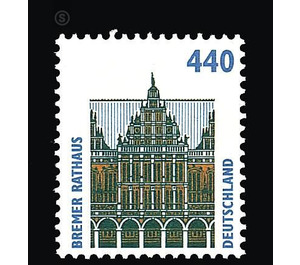Postage stamps: Places of interest - Germany / Federal Republic of Germany 1997 - 440 Pfennig
Theme: Architecture
| Country | Germany / Federal Republic of Germany |
| Issue Date | 1997 |
| Face Value | 440.00 |
| Color | brown white blue |
| Perforation | K 14 |
| Printing Type | indirect 2-color letterpress |
| Stamp Type | Postage stamp |
| Item Type | Stamp |
| Chronological Issue Number | 1810 |
| Chronological Chapter | GER-BRD |
| SID | 51924 |
| In 27 Wishlists | |
For almost 600 years, the Bremen City Hall has symbolized the claim to freedom and independence, which the Free Hanseatic City of Bremen has retained as the smallest among the 16 German states to this day. Its construction from 1405 marked a culmination of urban development, which coincided with the separation of Bremen from spiritual supremacy. 1410 was the building, as its builder an unspecified Master John is handed down, completed, whose gothic narrow building from the east and west is still clearly recognizable. Two storeys each contain a large hall, the "Untere" and the "Upper" Hall, the latter one of the "most distinguished ballrooms" in Germany. Simultaneously with the construction of the figures of the Emperor and the Elector, which were to represent the solidarity of the city to the Empire. Four other figures decorate the east and west sides, prophets and wise men. Between 1608 and 1616, a renovation in the mature style of the Weser Renaissance gave the Bremen town hall its current appearance. The leading artist personality was Lüder von Bentheim. Its façade design led to the construction of a mighty middle risalit crowned by a five-storey Flemish gable and complementary gables. The Gothic figures have been preserved, while at the newly designed arcades friezes and gussets have been decorated with a wealth of spiritual and secular allegories. From 1909 to 1913, the New Town Hall, a work of the Munich architect Gabriel von Seidl, was added. Over the centuries, the city hall, the most important building Bremen ever built, remained a jewel in its representative design as well as in the solemn dignity of its unique premises, among which the "Upper Hall" and the Gülden Chamber are the most prominent. (Text: Free Hanseatic City of Bremen)


